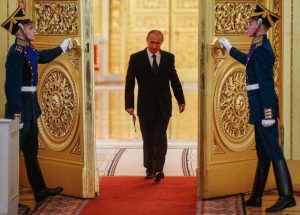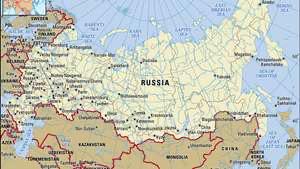RUSSIA’S HISTORIC MISSION IN THE MIDDLE-EAST FULFILLED AT LAST
By Pierre A. Sarkis

The beginning was with Tzar Peter the Great who ruled Russia in the 17th and 18th centuries when he realized that the Russian Empire would not achieve world status or develop into a world power, unless it possessed a navy to help the empire expand its influence around the globe, especially in Europe. This conviction came following his first victory over the Ottoman Empire in Southern Russia at the Sea of Azov, a tributary of the Black Sea. There, the Ottoman city of Azov came under Russian attack with the help of a primitive, underdeveloped navy hastily constructed and manned, but still gave such advantage to the Russians that they were able to take the port. That victory convinced Peter the Great of the importance of a navy for Russia, and in characteristic fashion, he turned all his energy to providing his empire with of one. Taganrog on the Sea of Azov became Russia’s first naval base.
After removing the threat presented by king Charles XII of Sweden in the North, Peter started to build a new modern city at the North-Western tip of the Baltic Sea as a Russian outlet to Northern and Western Europe. In 1703, the city bore his name “St. Petersburgh”, and it became the capital of the empire rather than the city of Moscow which was landlocked and far from any bodies of water. So, his new capital became the symbol of the naval force he built. However, one big problem was that ice covered the Baltic Sea and the White Sea to the north for a period of at least six months a year. That meant that the effectiveness of the Russian Navy depended to a great extent on the severity of Russian winters. Added to that, the Baltic Sea was mostly closed and all navigation out of it depended largely on the Great Belt Strait controlled by Denmark to the South.
The next step was implemented under the rule of Tzarina Catherine II the Great who ruled during the second half of the 18th century, and who was totally convinced of the importance of warm water ports, so that the Russian Navy could freely navigate on the high seas any time of the year. Thus, and under the wise direction of her strong advisor Gregory Potemkin, Russia was capable of defeating the Ottoman Empire yet again, and control the Crimean Peninsula in the Black Sea. From there, Catherine sent her navy in 1772 to the shores of the Eastern Mediterranean in support of a local chieftain, Daher Al Omar, who had rebelled against the Ottomans in Lebanon and Syria. The Russians withdrew when in 1774, Russia and the Ottomans signed an accord officially conceding both the Crimea and the Ukraine to Russia, but the problem of warm water ports was still not resolved. The Black Sea like the Baltic, was a closed sea and in order to have access to open waters, the Russian Navy needed to sail through the straits of the Bosphorus and the Dardanelles, both controlled by a mostly hostile Ottoman Empire. Again, the effectiveness of the Russian Navy depended on other factors, this time, good relations with the Ottomans.
By the early 1800s and with the Eastern Question (what to do with a weakened Ottoman Empire) becoming the focus of intense bickering and competition between European Empires and the Ottomans, Nicholas I became the new Russian Tzar. He immediately started to expand Russian power, especially in the Ottoman Empire. His fleet again reached the Eastern Mediterranean and the climax of Russian power in the East came through the Treaty of Unkiar-Skelessi, signed with the Ottomans in June, 1833. In a secret clause in the treaty, Ottoman Sultan Mohammed II agreed to deny entrance to the Black Sea to any European fleet that would threaten Russia. This came following Russia’s pledge to help the Sultan against the threat to the Ottomans presented by Mohammed Ali Pasha, the Mamluk Governor of Egypt. It was at this time that Nicholas branded the weakened Ottoman Empire and its Sultan as the “sick man of Europe”.
This increasing Russian power alarmed other European empires and especially the French, when Nicholas claimed the protection of the holy land and the Christian population in the East, previously a task that Napoleon III had taken upon himself. The majority of these Christians were Orthodox, like Russians, living in Palestine, Lebanon and Syria. Eventually, and in response to Russian power, the Ottoman, French, British, and later on Austrian empires launched a war against Russia known as the Crimean War of 1853-1856. Even with their defeat in the war, the Russians were able to keep their naval power in Sevastopol in the Crimea, on the Black Sea. By World War I, and after Russia’s withdrawal from the war following the Bolshevik revolution, the Soviet Union was born and along with it came different sets of regional interests for its new leadership.
During the Cold War, the Soviet Union especially under the leadership of Nikita Khrushchev and Leonid Brezhnev, established firm presence in the Middle East by signing treaties of friendship and cooperation with Egypt, Iraq, Syria and Libya. The Soviets started to send arms and military advisors to these countries, which legitimized the Soviet Union as a global power in the world with geopolitical, international and regional strategic interests. Still, the dream of controlling warm water ports was not achieved. Many Western analysts believed that the invasion of Afghanistan by the Soviet Union on December 27, 1979, was a Soviet push towards the warm waters of the Arabian Sea, close to the Strait of Hormuz at the entrance of the Persian Gulf where 60% of world oil exits to Europe and Asia. However, that too did not materialize.
And with the dissolution of the Soviet Union, the Russian Federation experienced a period of weakness and uncertainty providing the US and its European allies with the opportunity to expand the borders of the US-led NATO (North Atlantic Treaty Organization) to the South-Western borders of Russia. Ex-European Communist nations were offered membership in NATO which opened Moscow’s eyes to the attempts to encircle Russia. Russian distrust of US motives increased many folds when the US signed different accords with ex-Soviet Republics in Central Asia, such as, Kirghistan, Turkmenistan and others. Under terms of these accords, the US would provide economic and military assistance in exchange for US military bases.
With Vladimir Putin in power, the stage was set for a return to Russia’s glorious imperial past. This was fueled by what he considered to be the trickery of US President Barrack Obama and Nato in Libya, where Russian ally Libyan President Moammar Qaddafi was toppled without any consultations with Russia, as was the case before with Saddam Hussein of Iraq. Russia’s response was swift in the Ukraine which was being lured to join NATO, by annexing the Crimea which was originally Russian land but returned to the Ukraine by Soviet leader Nikita Khrushchev, a Ukrainian native. Then, Putin enticed Russian Ukrainians to revolt in the Eastern areas of the country adjacent to the Russian borders, which became under de facto Russian influence. It was very clear at this point that the US and its European allies clearly failed to assess the historic religious, cultural, economic and political importance of the Ukraine to Russia. Ukraine’s capital city of Kiev was the first Slavic Russian settlement (882 AD), known as Kievan Russia. It was also the cultural ancestor and predecessor of today’s Russia and the cradle of the Russian Orthodox Church (998 AD).
As it seemed perfectly legitimate for former US President George W. Bush to remove Saddam Hussein in Iraq to protect US interests, Vladimir Putin interfered in Syria to protect President Bashar Assad and protect Russian interests by constructing in North-Western Syria a naval base on warm water ports, a Russian historic dream. In addition, Russia’s goal to protect minorities from the threat of the Islamic State (ISIS) especially the Orthodox Christians, who were historically protected by Russia in the area, was confirmed by Mikhail Bogdanov, Assistant Russian Foreign Minister. Putin was also very nervous about Islamic extremism which forms a direct threat to internal Russian security and stability with over 4000 Chechnians and Dagestanis joining ISIS in fighting against the regime of Syrian President Bashar Assad. In a related context, Maria Zakharova, spokeswoman for the Russian Foreign Ministry warned about the presence of terrorist extremist Islamic groups in Northern Afghanistan on the borders of Tajikistan and Turkmenistan, areas of historic Russian strategic importance.
Where was the United States when Russian ships used to navigate in Middle Eastern waters three hundred years ago? In Russian thinking, if the US is a guarantor of Israel’s security, a US strategic ally, then Russia is the guarantor of Syria’s security, a Russian strategic ally. This seems to be of vital importance for Russian leadership as the world seems on the brink of a new cold war between the US, Russia and China where every territory and port of strategic significance seems to be under contention by the three powers.
The stakes are very high especially if Syria is partitioned into several smaller entities on a religious and confessional basis, as many strategic experts believe the case to be. These experts think that the upcoming Syrian presidential elections are the prelude to the partition of Syria since the Assad Regime has not spread its control over all of Syria’s territories with over 8 million Syrian refugees living in neighboring countries. Thus, the international community might challenge and reject the legitimacy of Assad’s assured re-election forcing the Syrian President to retreat to the North-Western corner of the country, where his religious sect the Alawites are a big majority, and declare an independent Alawite state. This will be the perfect scenario for Russia which can move in to create a relationship with Syria similar to that of the US and Israel. In this case, Russia would have entrenched itself in a strategic vital corner of the world, challenging the US and China in the up-coming new Tripartite Cold War.

However, and in concluding, the latest in a series of recent high-level meetings between Saudi and Syrian delegates in Damascus, as well as, the high-level visit of Assistant Saudi Defense Minister Khaled Bin Salman, brother of Mohamed Bin Salman to Baghdad, indicates that efforts are being exerted for the possibility of ending Syria’s isolation in the Arab World and its formal return to the Arab League. Such efforts will succeed when Arab countries recognize the legitimacy of the Syrian presidential elections and the presidency of Bashar Assad if elected. Then, and only then, could the threat of the partition of Syria be thwarted if not altogether avoided. This scenario will limit to a certain extent Russia’s territorial and political gains in a fully united Syrian state.
Bishmizzine, 14/05/2021
Expert in Russian Area Studies/The Soviet Union
Retired Instructor of International Relations, Political Science, History and Cultural Studies at the Lebanese American University, Byblos and Beirut.
References:
Brigadier-General Monzer El Ayoubi

